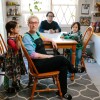Vladimir Shindich, 76

Vladimir Shindich
Age: 76
Wattles Community Farm, Hollywood
Saturday, March 5, 2022
I was born in April 1945, at the end of WWII. My mother was a Jewish partisan in Ukraine. My father was Belarusian, born in 1901. They had a big age difference. When Ukraine was liberated, everyone was sent to Kyiv to rebuild. My mom was transporting tar paper in war-ravaged Kyiv with a female friend. They were settled in a building with no window panes, and they were trying to cover up the windows. My father was driving, delivering something for the hospital where he was recovering, and he helped my mom and her friend. That’s how my parents met, and then I was born.
I remember Kyiv of back then very well -- war-ravaged, old, but nonetheless beautiful. When I came to Los Angeles in 1994 I was almost fifty years old. I spent the best years of my life in Kyiv with my friends, kids, mom, dad; I loved Kyiv very much. We bought a dacha [summer house] on the Desna River. It was wonderful there. I used to give tours of Kyiv during work conferences and everyone was always amazed by the city. When I saw how the Russian troops are attacking Kyiv now, my soul broke into pieces.
I worked in Chernobyl soon after the nuclear disaster in 1986 because I was in radiophysics at the time. I was in charge of one of four teams at the Academy of Sciences tasked with finding contaminated areas in Chernobyl and monitoring the ecology there. We had to make sure the radiation would not go to Kyiv, that it wouldn’t get in the water. I worked there for three years, every day with a dosimeter in hand. When I saw that the Russian troops attacked Chernobyl, I was scared because I understood what it meant. The Chechens who Putin brought in kicked out the workers, but they don’t know how to use the equipment. If you don’t know what you are doing, what remains could also blow up. Then they attacked the other power plant, Enerhodar.
I have relatives and friends from Moscow and Leningrad. When one of them who lives here tells me, “Do you see what your Ukrainians are doing, killing our people?” I look at him and can’t understand. I tell him, “What are you talking about?” He says to me, “Don’t you watch TV?” He watches Russian TV. I tell him, “I watch TV, but that’s not what’s going on there.” He hangs up and we don’t speak anymore.
I’m certain that Ukraine will not surrender. I know the people. I lived and worked with them. The young people who survive this will never forgive Russia. I think this is the hardest. You can get in an argument and still find common ground after. But after they kill your father, mother, child, wife, it’s impossible.













